Multicriteria Decision-Making for Evaluating Solar Energy Source of Saudi Arabia
Abstract
1. Introduction
- Designing of solar technology systems (PV and CSP) for three different cities of Saudi Arabis;
- Investigating the techno-economic performance of the two solar technologies;
- Comparative study of the proposed systems based on five parameters, i.e., climate, environmental, technical, economic, and social;
- Designing a Multi-Criteria Decision-making technique based on SAW and AHP to evaluate each solar technology at the three locations;
- Identifying the best location for each technology.
2. Methodology
2.1. Algorithm
0.026 × [C6] + 0.023 × [C7] + 0.115 × [C8] + 0.026 × [C9] +0.149 × [C10] + 0.122 × [C11] + 0.022 × [C12] + 0.085
× [C13]
2.2. Software Tool
2.2.1. PVSyst
2.2.2. SAM
2.3. System Design
2.3.1. Photovoltaic System
2.3.2. Solar Thermal System
3. Criteria Calculations
3.1. Climate
3.2. Technical Criteria
3.2.1. Energy Yield
3.2.2. System Losses
3.3. Environmental Losses
3.4. Economic Criteria
4. Multi-Criteria Decision Making (MCDM)
4.1. PV System MCDM
| 1 | 1 | 0.721 | 0.953 | 1 | 0.97 | 1 | 1 | 1 | 1 | 1 | 0.822 | 0.253 | |
| Xij= | 0.887 | 0.681 | 0.581 | 0.799 | 0.88 | 0.855 | 0.865 | 0.702 | 0.821 | 0.86 | 0.862 | 0.923 | 1 |
| 0.817 | 0.718 | 1 | 1 | 0.83 | 1 | 0.8 | 0.565 | 0.73 | 0.813 | 0.799 | 1 | 0.141 |
× [1] + 0.026 × [1] +0.149 × [1] + 0.122 × [1] + 0.022 × [0.822] + 0.085 × [0.253] = 0.919003
× [0.865] + 0.115 × [0.702] + 0.026 × [0.821] +0.149 × [0.86] + 0.122 × [0.862] + 0.022 × [0.923] + 0.085 × [1] =
0.836718
0.115 × [0.565] + 0.026 × [0.73] +0.149 × [0.813] + 0.122 × [0.799] + 0.022 × [0.1] + 0.085 × [0.141] = 0.735097
4.2. Parabolic Trough system MCDM
| 1 | 0.680 | 0.806 | 0.953 | 0.990 | 0.958 | 0.948 | 0.996 | 0.971 | 0.990 | 0.99 | 0.992 | 0.253 | |
| Xij= | 0.887 | 1 | 1 | 0.799 | 1 | 0.929 | 1 | 1 | 1 | 1 | 1 | 0.983 | 1 |
| 0.817 | 0.947 | 0.581 | 1 | 0.982 | 1 | 0.98 | 0.995 | 0.935 | 0.976 | 0.981 | 1 | 0.141 |
4.3. PV and PT System MCDM
| 1 | 1 | 0.72 | 0.953 | 0.791 | 0.969 | 1 | 0.707 | 1 | 0.791 | 0.785 | 0.821 | 0.253 | |
| 1 | 0.680 | 0.80 | 0.953 | 0.990 | 0.708 | 0.206 | 0.996 | 0.438 | 0.99 | 0.990 | 0.662 | 0.253 | |
| Xij= | 0.887 | 0.681 | 0.58 | 0.799 | 0.700 | 0.854 | 0.864 | 0.496 | 0.821 | 0.680 | 0.677 | 0.923 | 1 |
| 0.887 | 1 | 1 | 0.799 | 1 | 0.686 | 0.217 | 1 | 0.450 | 1 | 1 | 0.656 | 1 | |
| 0.817 | 0.718 | 1 | 1 | 0.657 | 1 | 0.8 | 0.399 | 0.730 | 0.643 | 0.627 | 1 | 0.141 | |
| 2019 | 0.947 | 0.58 | 1 | 0.982 | 0.739 | 0.213 | 0.995 | 0.422 | 0.976 | 0.982 | 0.667 | 0.141 |
4.4. Equal Weight MCDM
0.077 × [C6] + 0.077 × [C7] + 0.077 × [C8] + 0.077 × [C9] + 0.077 × [C10] + 0.077 × [C11] + 0.077 × [C12] + 0.077
× [C13]
5. Theoretical Implications and Managerial Insights
5.1. Theoretical Implications
5.2. Managerial Insights
6. Limitations and Futuristic Scope
6.1. Limitations
6.2. Futuristic Scope
7. Conclusions
Author Contributions
Funding
Data Availability Statement
Conflicts of Interest
References
- Dincer, F. The analysis on wind energy electricity generation status, potential and policies in the world. Renew. Sustain. Energy Rev. 2011, 15, 5135–5142. [Google Scholar] [CrossRef]
- Raheem, A.; Abbasi, S.A.; Memon, A.; Samo, S.R.; Taufiq-Yap, Y.H.; Danquah, M.K.; Harun, R. Renewable energy deployment to combat energy crisis in Pakistan. Energy Sustain. Soc. 2016, 6, 16. [Google Scholar] [CrossRef]
- Ashfaq, A.; Ianakiev, A. Features of fully integrated renewable energy atlas for Pakistan; wind, solar and cooling. Renew. Sustain. Energy Rev. 2018, 97, 14–27. [Google Scholar] [CrossRef]
- Ludin, N.A.; Mustafa, N.I.; Hanafiah, M.M.; Ibrahim, M.A.; Teridi, M.A.M.; Sepeai, S.; Zaharim, A.; Sopian, K. Prospects of life cycle assessment of renewable energy from solar photovoltaic technologies: A review. Renew. Sustain. Energy Rev. 2018, 96, 11–28. [Google Scholar] [CrossRef]
- Qu, M.; Ahponen, P.; Tahvanainen, L.; Gritten, D.; Mola-Yudego, B.; Pelkonen, P. Chinese university students’ knowledge and attitudes regarding forest bio-energy. Renew. Sustain. Energy Rev. 2011, 15, 3649–3657. [Google Scholar] [CrossRef]
- Lucas, H.; Pinnington, S.; Cabeza, L.F. Education and training gaps in the renewable energy sector. Sol. Energy 2018, 173, 449–455. [Google Scholar] [CrossRef]
- Trop, P.; Goricanec, D. Comparisons between energy carriers’ productions for exploiting renewable energy sources. Energy 2016, 108, 155–161. [Google Scholar] [CrossRef]
- Fornara, F.; Pattitoni, P.; Mura, M.; Strazzera, E. Predicting intention to improve household energy efficiency: The role of value-belief-norm theory, normative and informational influence, and specific attitude. J. Environ. Psychol. 2016, 45, 1–10. [Google Scholar] [CrossRef]
- Mardani, A.; Jusoh, A.; Zavadskas, E.; Cavallaro, F.; Khalifah, Z. Sustainable and Renewable Energy: An Overview of the Application of Multiple Criteria Decision Making Techniques and Approaches. Sustainability 2015, 7, 13947–13984. [Google Scholar] [CrossRef]
- Borovik, M.R.; Albers, J.D. Participation in the Illinois solar renewable energy market. Electr. J. 2018, 31, 33–39. [Google Scholar] [CrossRef]
- Kousksou, T.; Bruel, P.; Jamil, A.; El Rhafiki, T.; Zeraouli, Y. Energy storage: Applications and challenges. Sol. Energy Mater. Sol. Cells 2014, 120, 59–80. [Google Scholar] [CrossRef]
- Stigka, E.K.; Paravantis, J.A.; Mihalakakou, G.K. Social acceptance of renewable energy sources: A review of contingent valuation applications. Renew. Sustain. Energy Rev. 2014, 32, 100–106. [Google Scholar] [CrossRef]
- Tsagarakis, K.P.; Mavragani, A.; Jurelionis, A.; Prodan, I.; Andrian, T.; Bajare, D.; Korjakins, A.; Magelinskaite-Legkauskiene, S.; Razvan, V.; Stasiuliene, L. Clean vs. Green: Redefining renewable energy. Evidence from Latvia, Lithuania, and Romania. Renew. Energy 2018, 121, 412–419. [Google Scholar] [CrossRef]
- Zografakis, N.; Sifaki, E.; Pagalou, M.; Nikitaki, G.; Psarakis, V.; Tsagarakis, K.P. Assessment of public acceptance and willingness to pay for renewable energy sources in Crete. Renew. Sustain. Energy Rev. 2010, 14, 1088–1095. [Google Scholar] [CrossRef]
- Bayulgen, O.; Benegal, S. Green Priorities: How economic frames affect perceptions of renewable energy in the United States. Energy Res. Soc. Sci. 2019, 47, 28–36. [Google Scholar] [CrossRef]
- Keramitsoglou, K.M.; Mellon, R.C.; Tsagkaraki, M.I.; Tsagarakis, K.P. Clean, not green: The effective representation of renewable energy. Renew. Sustain. Energy Rev. 2016, 59, 1332–1337. [Google Scholar] [CrossRef]
- Rad, M.A.V.; Ghasempour, R.; Rahdan, P.; Mousavi, S.; Arastounia, M. Techno-economic analysis of a hybrid power system based on the cost-effective hydrogen production method for rural electrification, a case study in Iran. Energy 2020, 190, 116421. [Google Scholar] [CrossRef]
- Hoseinzadeh, S.; Garcia, D.A. Techno-economic assessment of hybrid energy flexibility systems for islands’ decarbonization: A case study in Italy. Sustain. Energy Technol. Assess. 2022, 51, 101929. [Google Scholar] [CrossRef]
- Ali, M.; Wazir, R.; Imran, K.; Ullah, K.; Janjua, A.K.; Ulasyar, A.; Khattak, A.; Guerrero, J.M. Techno-economic assessment and sustainability impact of hybrid energy systems in Gilgit-Baltistan, Pakistan. Energy Rep. 2021, 7, 2546–2562. [Google Scholar] [CrossRef]
- Kumar, D.; Tewary, T. Techno-economic assessment and optimization of a standalone residential hybrid energy system for sustainable energy utilization. Int. J. Energy Res. 2022, 46, 10020–10039. [Google Scholar] [CrossRef]
- Seedahmed, M.M.A.; Ramli, M.A.M.; Bouchekara, H.R.E.H.; Shahriar, M.S.; Milyani, A.H.; Rawa, M. A techno-economic analysis of a hybrid energy system for the electrification of a remote cluster in western Saudi Arabia. Alex. Eng. J. 2022, 61, 5183–5202. [Google Scholar] [CrossRef]
- Akan, A.E. Techno-economic analysis of an off-grid hybrid energy system with homer pro. Icontech Int. J. 2021, 5, 56–61. [Google Scholar] [CrossRef]
- Khan, F.A.; Pal, N.; Saeed, S.H.; Yadav, A. Techno-economic and feasibility assessment of standalone solar Photovoltaic/Wind hybrid energy system for various storage techniques and different rural locations in India. Energy Convers. Manag. 2022, 270, 116217. [Google Scholar] [CrossRef]
- Gielen, D.; Boshell, F.; Saygin, D.; Bazilian, M.D.; Wagner, N.; Gorini, R. The role of renewable energy in the global energy transformation. Energy Strategy Rev. 2019, 24, 38–50. [Google Scholar] [CrossRef]
- Lange, M.A. Impacts of Climate Change on the Eastern Mediterranean and the Middle East and North Africa Region and the Water–Energy Nexus. Atmosphere 2019, 10, 455. [Google Scholar] [CrossRef]
- Khan, M.; Asif, M.; Stach, E. Rooftop PV Potential in the Residential Sector of the Kingdom of Saudi Arabia. Buildings 2017, 7, 46. [Google Scholar] [CrossRef]
- Almasoud, A.H.; Gandayh, H.M. Future of solar energy in Saudi Arabia. J. King Saud Univ.-Eng. Sci. 2015, 27, 153–157. [Google Scholar] [CrossRef]
- Amran, Y.H.A.; Amran, Y.H.M.; Alyousef, R.; Alabduljabbar, H. Renewable and sustainable energy production in Saudi Arabia according to Saudi Vision 2030; Current status and future prospects. J. Clean. Prod. 2020, 247, 119602. [Google Scholar] [CrossRef]
- Tlili, I. Renewable energy in Saudi Arabia: Current status and future potentials. Environ. Dev. Sustain. 2015, 17, 859–886. [Google Scholar] [CrossRef]
- Alnatheer, O. The potential contribution of renewable energy to electricity supply in Saudi Arabia. Energy Policy 2005, 33, 2298–2312. [Google Scholar] [CrossRef]
- Boretti, A. Cost and production of solar thermal and solar photovoltaics power plants in the United States. Renew. Energy Focus 2018, 26, 93–99. [Google Scholar] [CrossRef]
- Patel, H.; Agarwal, V. Maximum Power Point Tracking Scheme for PV Systems Operating Under Partially Shaded Conditions. IEEE Trans. Ind. Electron. 2008, 55, 1689–1698. [Google Scholar] [CrossRef]
- Bishoyi, D.; Sudhakar, K. Modeling and performance simulation of 100 MW PTC based solar thermal power plant in Udaipur India. Case Stud. Therm. Eng. 2017, 10, 216–226. [Google Scholar] [CrossRef]
- Pohekar, S.D.; Ramachandran, M. Application of multi-criteria decision making to sustainable energy planning—A review. Renew. Sustain. Energy Rev. 2004, 8, 365–381. [Google Scholar] [CrossRef]
- Kumar, N.M.; Kumar, M.R.; Rejoice, P.R.; Mathew, M. Performance analysis of 100 kWp grid connected Si-poly photovoltaic system using PVsyst simulation tool. Energy Procedia 2017, 117, 180–189. [Google Scholar] [CrossRef]
- Dehghan, H.; Pourfayaz, F.; Shahsavari, A. Multicriteria decision and Geographic Information System-based locational analysis and techno-economic assessment of a hybrid energy system. Renew. Energy 2022, 198, 189–199. [Google Scholar] [CrossRef]
- Mahesh, A.; Sandhu, K.S. A genetic algorithm based improved optimal sizing strategy for solar-wind-battery hybrid system using energy filter algorithm. Front. Energy 2020, 14, 139–151. [Google Scholar] [CrossRef]
- Al Garni, H.Z.; Awasthi, A. Solar PV Power Plants Site Selection. In Advances in Renewable Energies and Power Technologies; Elsevier: Amsterdam, The Netherlands, 2018; pp. 57–75. [Google Scholar] [CrossRef]
- Diemuodeke, E.O.; Addo, A.; Oko, C.O.C.; Mulugetta, Y.; Ojapah, M.M. Optimal mapping of hybrid renewable energy systems for locations using multi-criteria decision-making algorithm. Renew. Energy 2019, 134, 461–477. [Google Scholar] [CrossRef]
- Konneh, D.; Howlader, H.; Shigenobu, R.; Senjyu, T.; Chakraborty, S.; Krishna, N. A Multi-Criteria Decision Maker for Grid-Connected Hybrid Renewable Energy Systems Selection Using Multi-Objective Particle Swarm Optimization. Sustainability 2019, 11, 1188. [Google Scholar] [CrossRef]
- Dehshiri, S.S.H. A new application of multi criteria decision making in energy technology in traditional buildings: A case study of Isfahan. Energy 2022, 240, 122814. [Google Scholar] [CrossRef]
- Ibrahim, A.; Surya, R.A. The Implementation of Simple Additive Weighting (SAW) Method in Decision Support System for the Best School Selection in Jambi. J. Phys. Conf. Ser. 2019, 1338, 012054. [Google Scholar] [CrossRef]
- Xu, X.; Li, Y.; Huang, T.; Xue, Y.; Peng, K.; Qi, L.; Dou, W. An energy-aware computation offloading method for smart edge computing in wireless metropolitan area networks. J. Netw. Comput. Appl. 2019, 133, 75–85. [Google Scholar] [CrossRef]
- Mostafaeipour, A.; Sedeh, A.S. Investigation of solar energy utilization for production of hydrogen and sustainable chemical fertilizer: A case study. Int. J. Energy Res. 2019, 43, er.4829. [Google Scholar] [CrossRef]
- Zhou, S.; Yang, P. Risk management in distributed wind energy implementing Analytic Hierarchy Process. Renew. Energy 2020, 150, 616–623. [Google Scholar] [CrossRef]
- Raghav, L.P.; Kumar, R.S.; Raju, D.K.; Singh, A.R. Analytic Hierarchy Process (AHP)—Swarm intelligence based flexible demand response management of grid-connected microgrid. Appl. Energy 2022, 306, 118058. [Google Scholar] [CrossRef]
- Baseer, M.A.; Rehman, S.; Meyer, J.P.; Alam, M.M. GIS-based site suitability analysis for wind farm development in Saudi Arabia. Energy 2017, 141, 1166–1176. [Google Scholar] [CrossRef]
- Kharrich, M.; Kamel, S.; Alghamdi, A.S.; Eid, A.; Mosaad, M.I.; Akherraz, M.; Abdel-Akher, M. Optimal Design of an Isolated Hybrid Microgrid for Enhanced Deployment of Renewable Energy Sources in Saudi Arabia. Sustainability 2021, 13, 4708. [Google Scholar] [CrossRef]
- Almasad, A.; Pavlak, G.; Alquthami, T.; Kumara, S. Site suitability analysis for implementing solar PV power plants using GIS and fuzzy MCDM based approach. Sol. Energy 2023, 249, 642–650. [Google Scholar] [CrossRef]
- Mashal, I.; Alsaryrah, O.; Chung, T.-Y.; Yuan, F.-C. A multi-criteria analysis for an internet of things application recommendation system. Technol. Soc. 2020, 60, 101216. [Google Scholar] [CrossRef]
- Kumar, N.; Singh, T.; Grewal, J.S.; Patnaik, A.; Fekete, G. A novel hybrid AHP-SAW approach for optimal selection of natural fiber reinforced non-asbestos organic brake friction composites. Mater. Res. Express 2019, 6, 065701. [Google Scholar] [CrossRef]
- Mohammad, G.S.; Alizadeh, M.S.; Hayati, S.S.H. A Fuzzy MADM Approach for Selecting the Best Cyanide Removal Method from a Gold Mine Wastewater. Res. Sq. 2021. [Google Scholar] [CrossRef]
- Mu, E.; Pereyra-Rojas, M. Practical Decision Making Using Super Decisions v3; Springer International Publishing: Cham, Switzerland, 2018. [Google Scholar] [CrossRef]
- Al-Badi, A.; Al Wahaibi, A.; Ahshan, R.; Malik, A. Techno-Economic Feasibility of a Solar-Wind-Fuel Cell Energy System in Duqm, Oman. Energies 2022, 15, 5379. [Google Scholar] [CrossRef]
- Riayatsyah, T.M.I.; Geumpana, T.A.; Fattah, I.M.R.; Rizal, S.; Mahlia, T.M.I. Techno-Economic Analysis and Optimisation of Campus Grid-Connected Hybrid Renewable Energy System Using HOMER Grid. Sustainability 2022, 14, 7735. [Google Scholar] [CrossRef]
- Shahzad, M.K.; Zahid, A.; Rashid, T.U.; Rehan, M.A.; Ali, M.; Ahmad, M. Techno-economic feasibility analysis of a solar-biomass off grid system for the electrification of remote rural areas in Pakistan using HOMER software. Renew. Energy 2017, 106, 264–273. [Google Scholar] [CrossRef]
- Wahid, S.S.A.; Arief, Y.Z.; Mubarakah, N. Optimization of Hybrid Renewable Energy in Malaysia Remote Rural Area Using HOMER Software. In Proceedings of the 2019 3rd International Conference on Electrical, Telecommunication and Computer Engineering (ELTICOM), Medan, Indonesia, 16–17 September 2019; pp. 111–115. [Google Scholar] [CrossRef]
- Awan, A.; Zubair, M. Performance Analysis and Optimization of a Parabolic Trough Solar Power Plant in the Middle East Region. Energies 2018, 11, 741. [Google Scholar] [CrossRef]
- Gong, J.; Huang, J.; Hu, X.; Wang, J.; Lund, P.D.; Gao, C. Optimizing research on large-aperture parabolic trough condenser using two kinds of absorber tubes with reflector at 500 °C. Renew. Energy 2021, 179, 2187–2197. [Google Scholar] [CrossRef]
- Nelson, S.; Luu, M.T.; Suo, S.; Milani, D.; Abbas, A. A CFD study of a direct solar-driven desorption process for carbon capture under transient conditions. Sustain. Energy Technol. Assess. 2021, 47, 101516. [Google Scholar] [CrossRef]
- Ghazouani, M.; Bouya, M.; Benaissa, M.; Anoune, K.; Ghazi, M. Thermal energy management optimization of solar thermal energy system based on small parabolic trough collectors for bitumen maintaining on heat process. Sol. Energy 2020, 211, 1403–1421. [Google Scholar] [CrossRef]
- Turkdogan, S. Design and optimization of a solely renewable based hybrid energy system for residential electrical load and fuel cell electric vehicle. Eng. Sci. Technol. Int. J. 2021, 24, 397–404. [Google Scholar] [CrossRef]
- Chisale, S.W.; Mangani, P. Energy Audit and Feasibility of Solar PV Energy System: Case of a Commercial Building. J. Energy 2021, 2021, 1–9. [Google Scholar] [CrossRef]
- Solangi, Y.A.; Shah, S.A.A.; Zameer, H.; Ikram, M.; Saracoglu, B.O. Assessing the solar PV power project site selection in Pakistan: Based on AHP-fuzzy VIKOR approach. Environ. Sci. Pollut. Res. 2019, 26, 30286–30302. [Google Scholar] [CrossRef]
- Irfan, M.; Zhao, Z.Y.; Ahmad, M.; Rehman, A. A techno-economic analysis of off-grid solar PV system: A case study for Punjab province in Pakistan. Processes 2019, 7, 708. [Google Scholar] [CrossRef]
- Tahir, S.; Ahmad, M.; Abd-ur-Rehman, H.M.; Shakir, S. Techno-economic assessment of concentrated solar thermal power generation and potential barriers in its deployment in Pakistan. J. Clean. Prod. 2021, 293, 126125. [Google Scholar] [CrossRef]
- Abdelhady, S. Performance and cost evaluation of solar dish power plant: Sensitivity analysis of levelized cost of electricity (LCOE) and net present value (NPV). Renew. Energy 2021, 168, 332–342. [Google Scholar] [CrossRef]
- Wang, G.; Chao, Y.; Jiang, T.; Chen, Z. Facilitating developments of solar thermal power and nuclear power generations for carbon neutral: A study based on evolutionary game theoretic method. Sci. Total Environ. 2022, 814, 151927. [Google Scholar] [CrossRef]
- Yan, H.; Li, X.; Liu, M.; Chong, D.; Yan, J. Performance analysis of a solar-aided coal-fired power plant in off-design working conditions and dynamic process. Energy Convers. Manag. 2020, 220, 113059. [Google Scholar] [CrossRef]
- Huang, C.; Hou, H.; Hu, E.; Liang, M.; Yang, Y. Impact of power station capacities and sizes of solar field on the performance of solar aided power generation. Energy 2017, 139, 667–679. [Google Scholar] [CrossRef]
- Li, C.; Zhai, R.; Sun, Y. Thermal and economic performances comparison of different pulverized coal power systems augmented by solar trough or tower technologies. Case Stud. Therm. Eng. 2022, 34, 102009. [Google Scholar] [CrossRef]
- Baneshi, M.; Hadianfard, F. Techno-economic feasibility of hybrid diesel/PV/wind/battery electricity generation systems for non-residential large electricity consumers under southern Iran climate conditions. Energy Convers. Manag. 2016, 127, 233–244. [Google Scholar] [CrossRef]
- Fazelpour, F.; Soltani, N.; Rosen, M.A. Economic analysis of standalone hybrid energy systems for application in Tehran, Iran. Int. J. Hydrogen Energy 2016, 41, 7732–7743. [Google Scholar] [CrossRef]
- Shami, S.H.; Ahmad, J.; Zafar, R.; Haris, M.; Bashir, S. Evaluating wind energy potential in Pakistan’s three provinces, with proposal for integration into national power grid. Renew. Sustain. Energy Rev. 2016, 53, 408–421. [Google Scholar] [CrossRef]
- Anwar, K.; Deshmukh, S.; Rizvi, S.M. Feasibility and Sensitivity Analysis of a Hybrid Photovoltaic/Wind/Biogas/Fuel-Cell/Diesel/Battery System for Off-Grid Rural Electrification Using homer. J. Energy Resour. Technol. 2020, 142, 061307. [Google Scholar] [CrossRef]
- Rehmani, A.M.; Akhter, P. Techno-Economic analysis of hybrid renewable energy systems for rural area energization in Pakistan. In Proceedings of the 2019 3rd International Conference on Energy Conservation and Efficiency (ICECE), Lahore, Pakistan, 23–24 October 2019; pp. 1–6. [Google Scholar] [CrossRef]
- Nesamalar, J.J.D.; Suruthi, S.; Raja, S.C.; Tamilarasu, K. Techno-economic analysis of both on-grid and off-grid hybrid energy system with sensitivity analysis for an educational institution. Energy Convers. Manag. 2021, 239, 114188. [Google Scholar] [CrossRef]
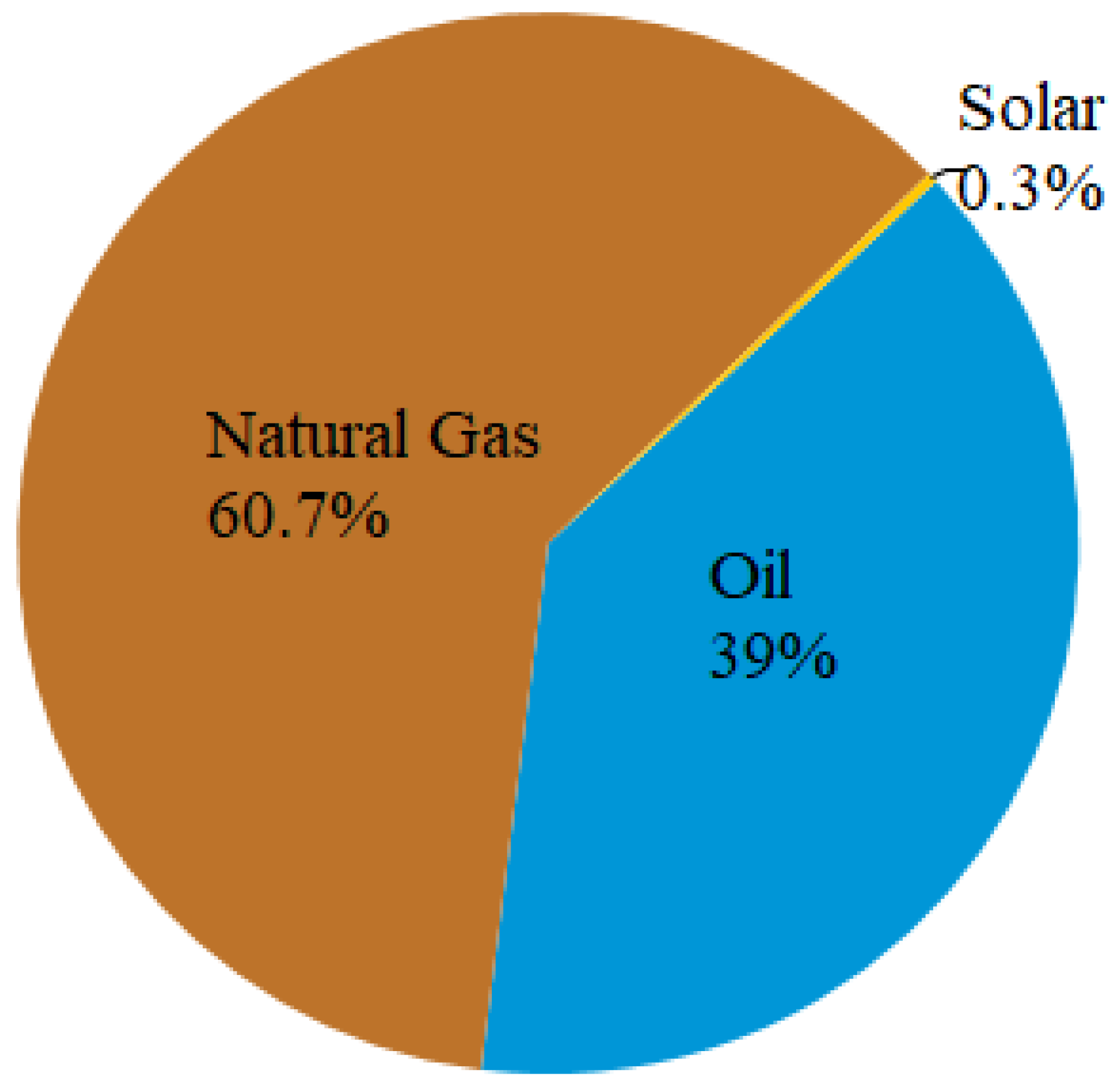
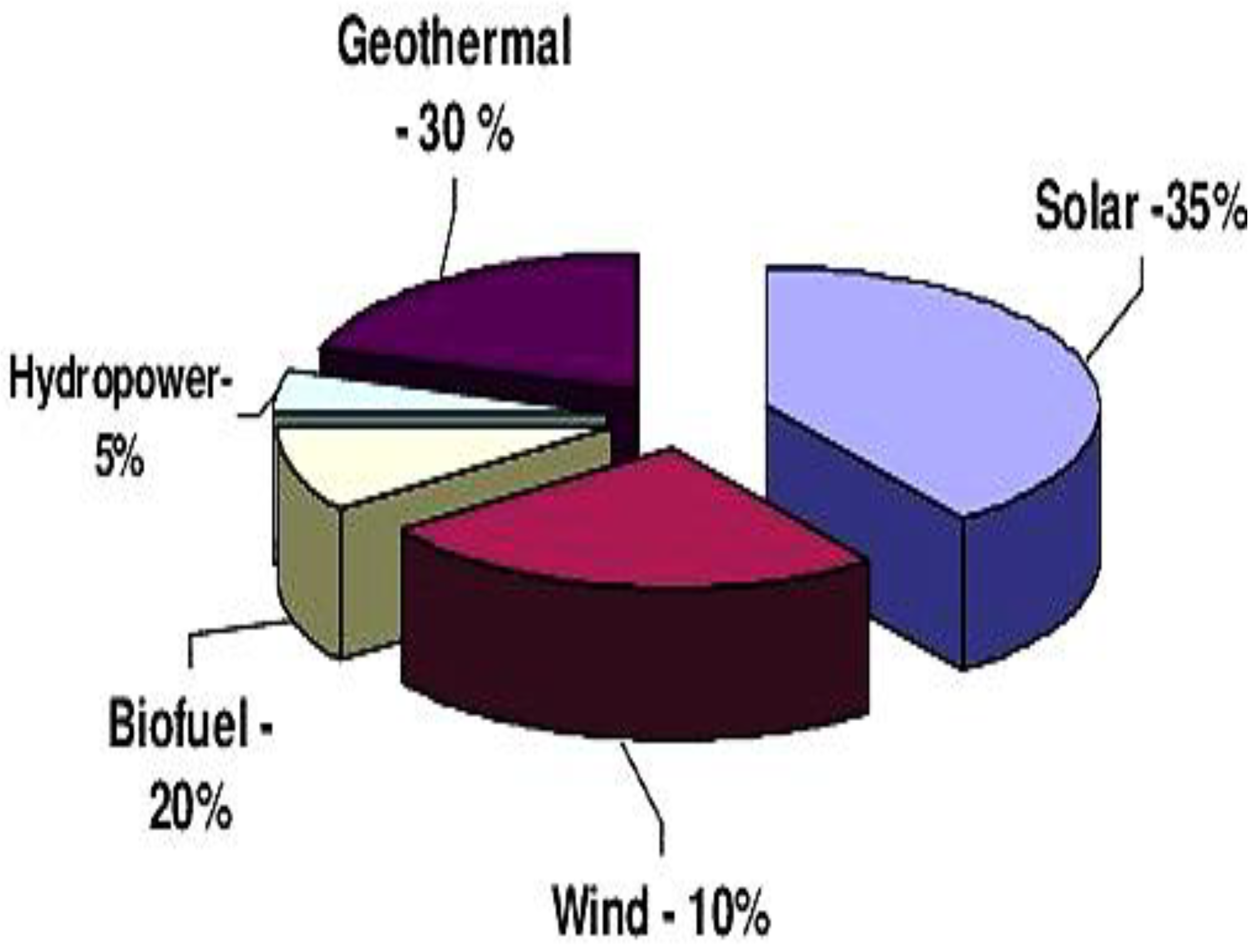
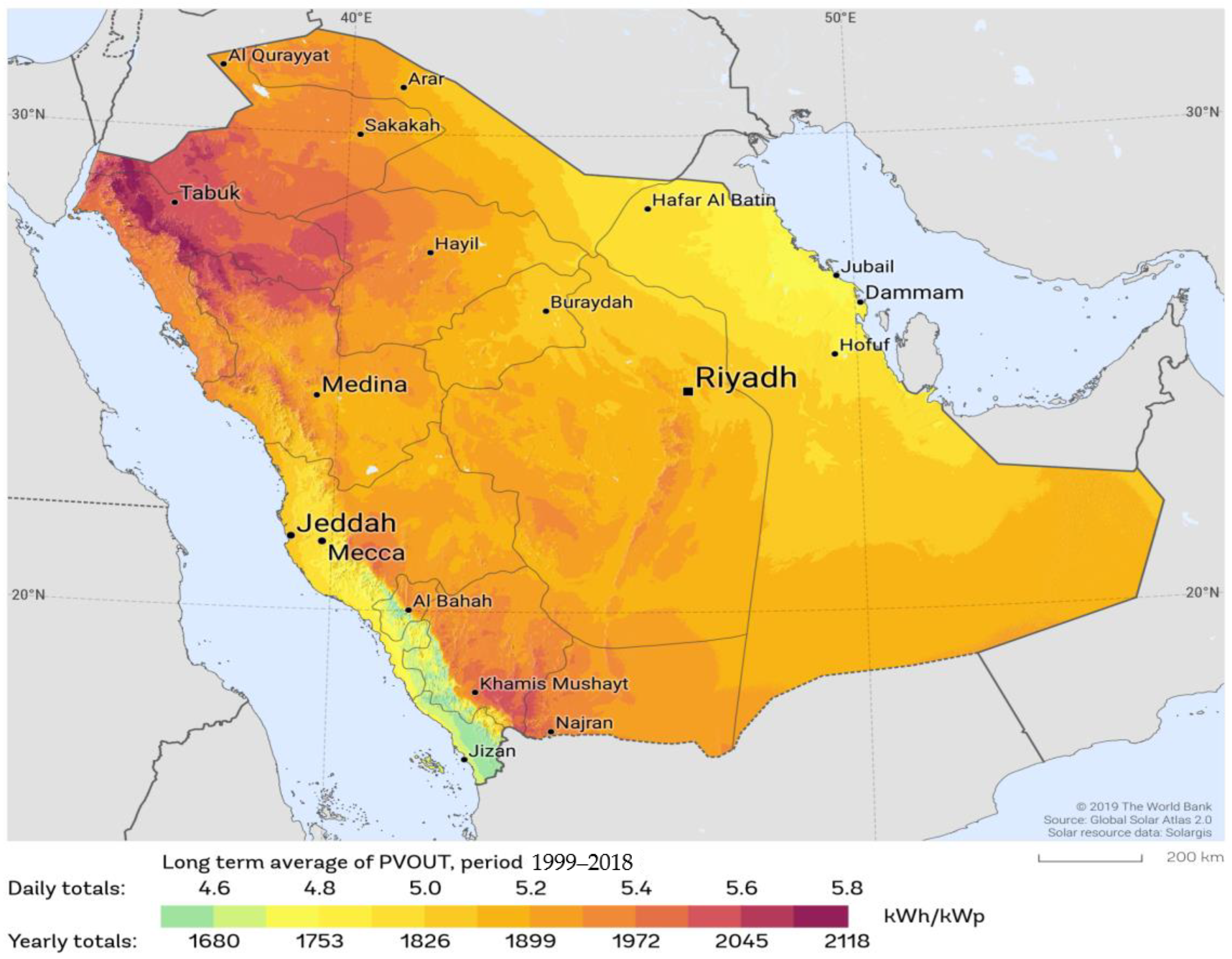
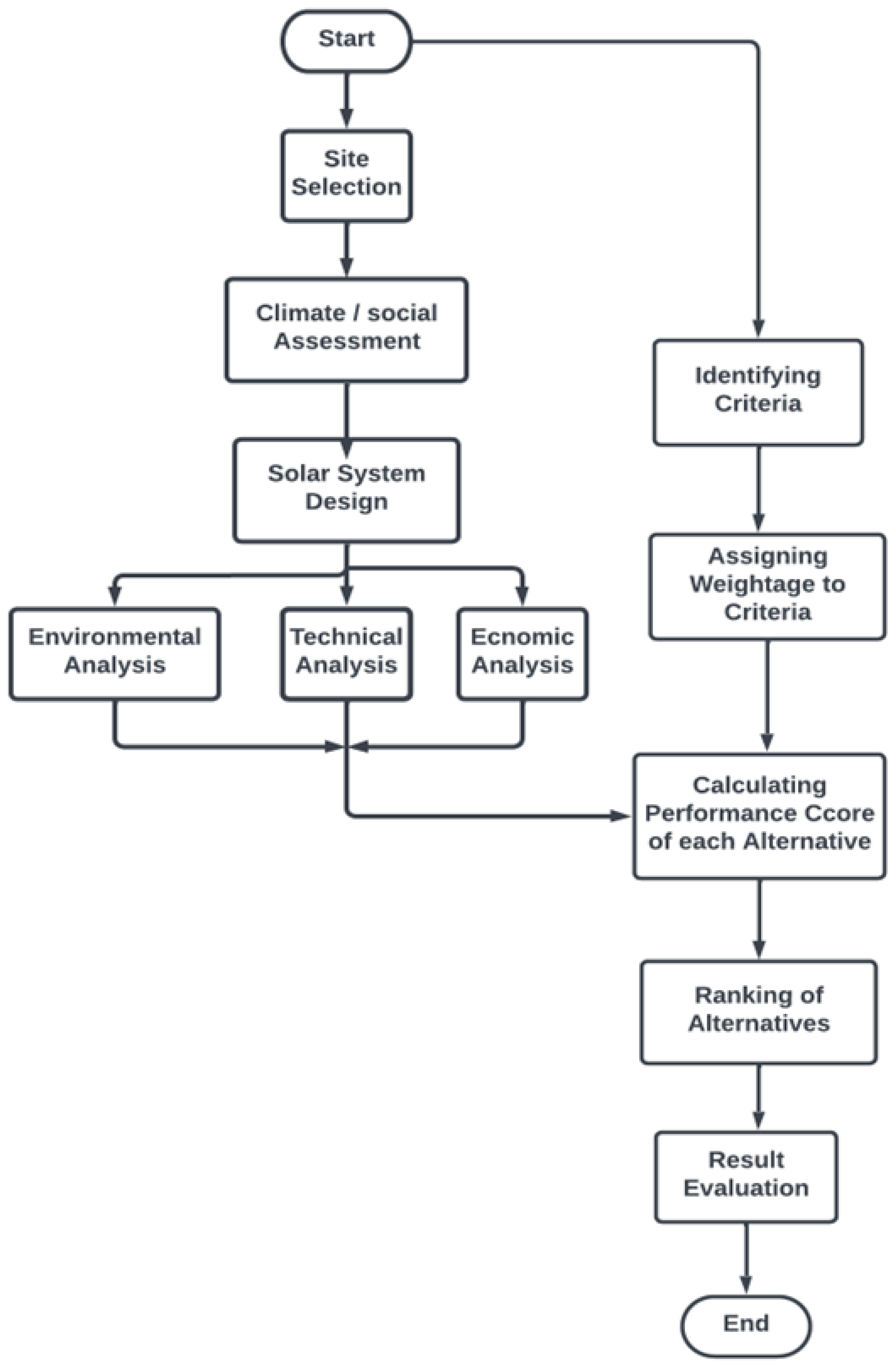
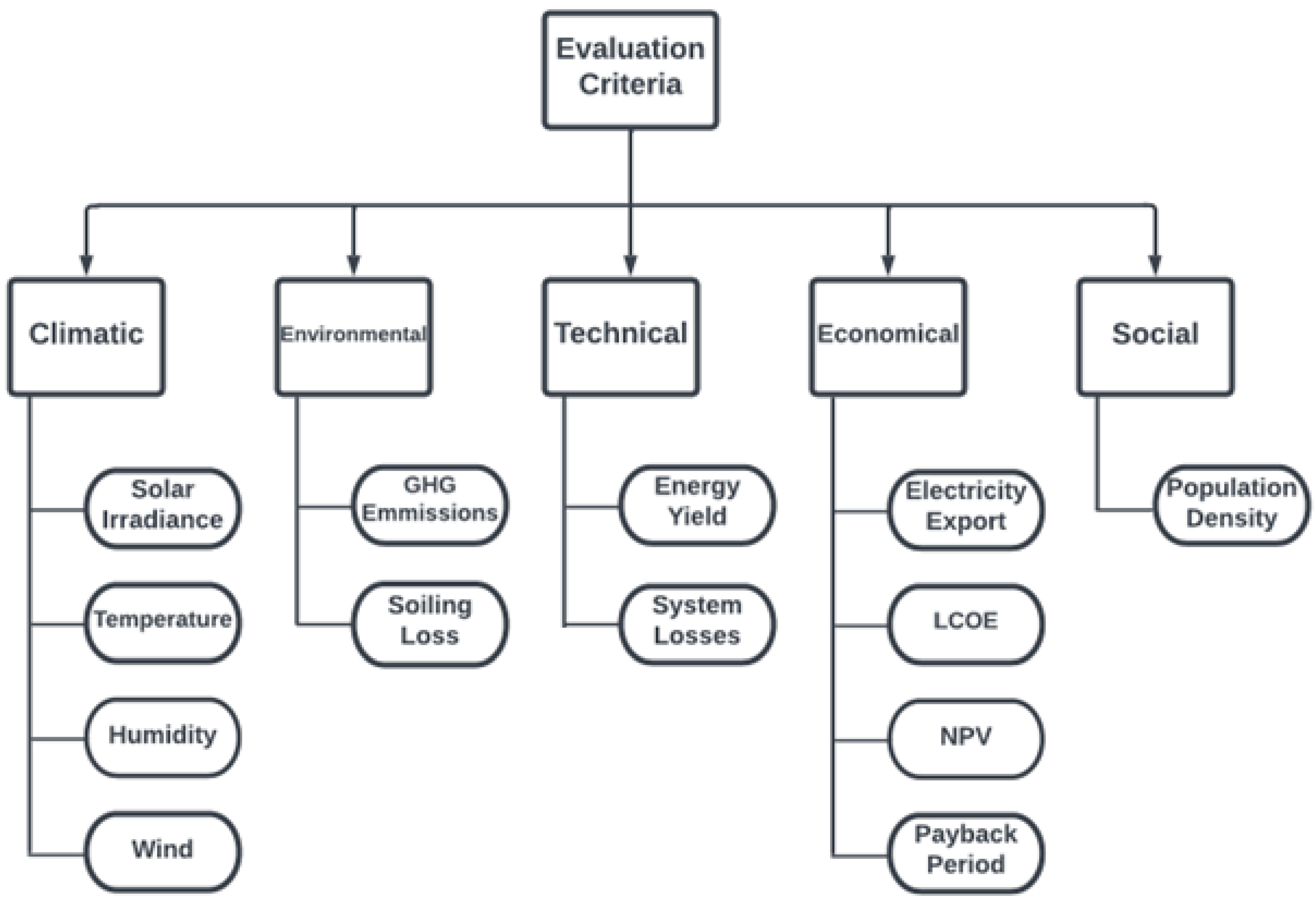

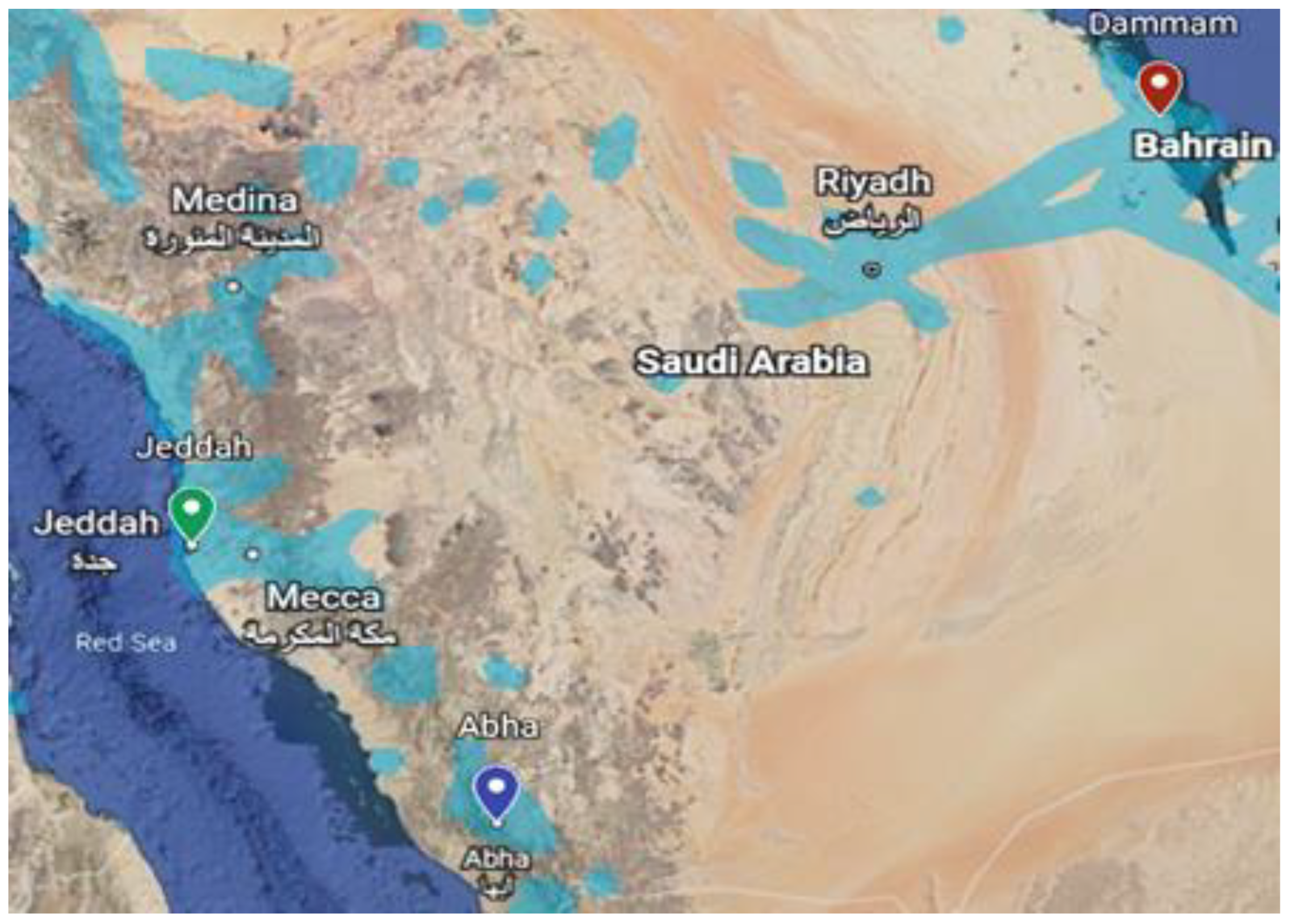
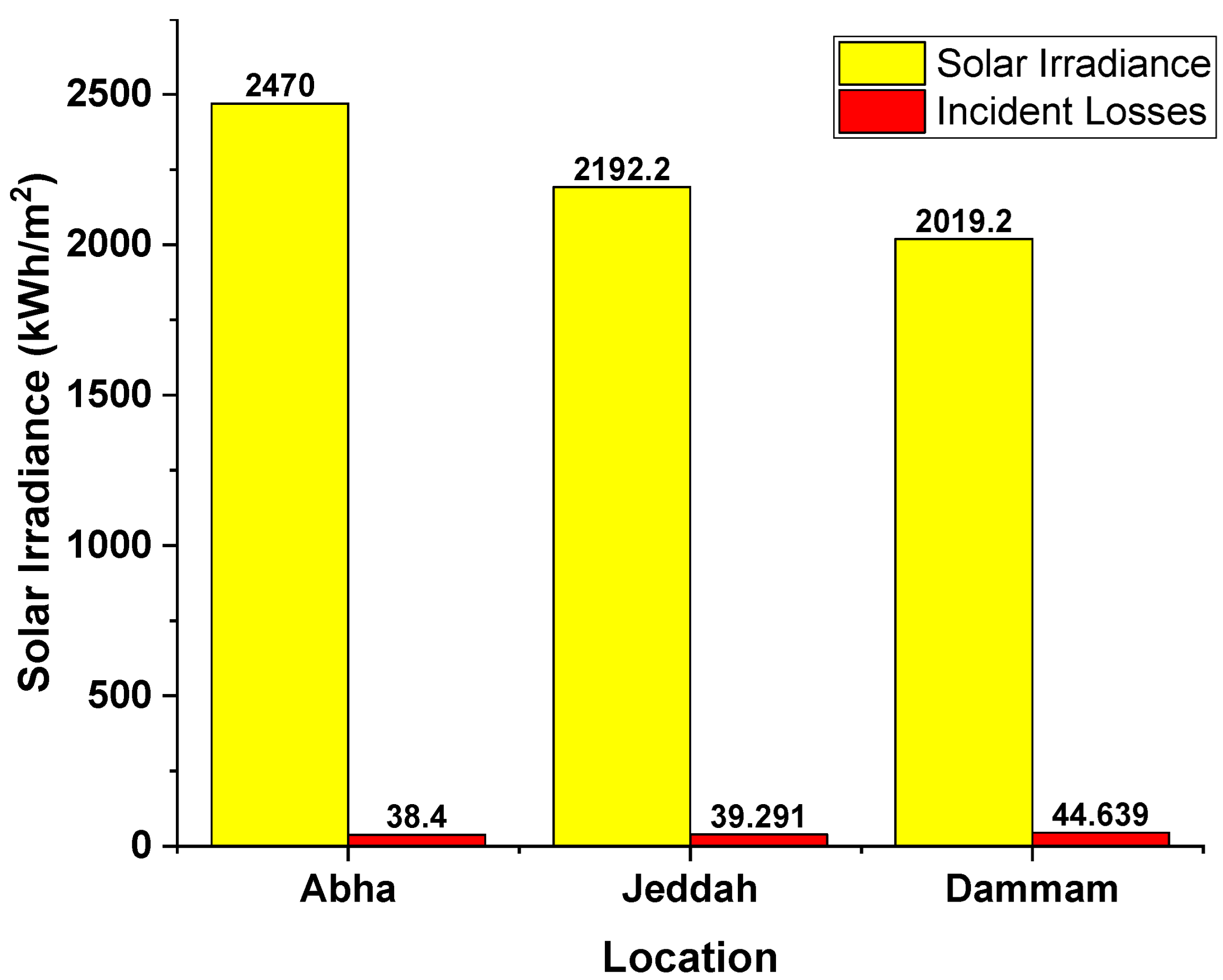
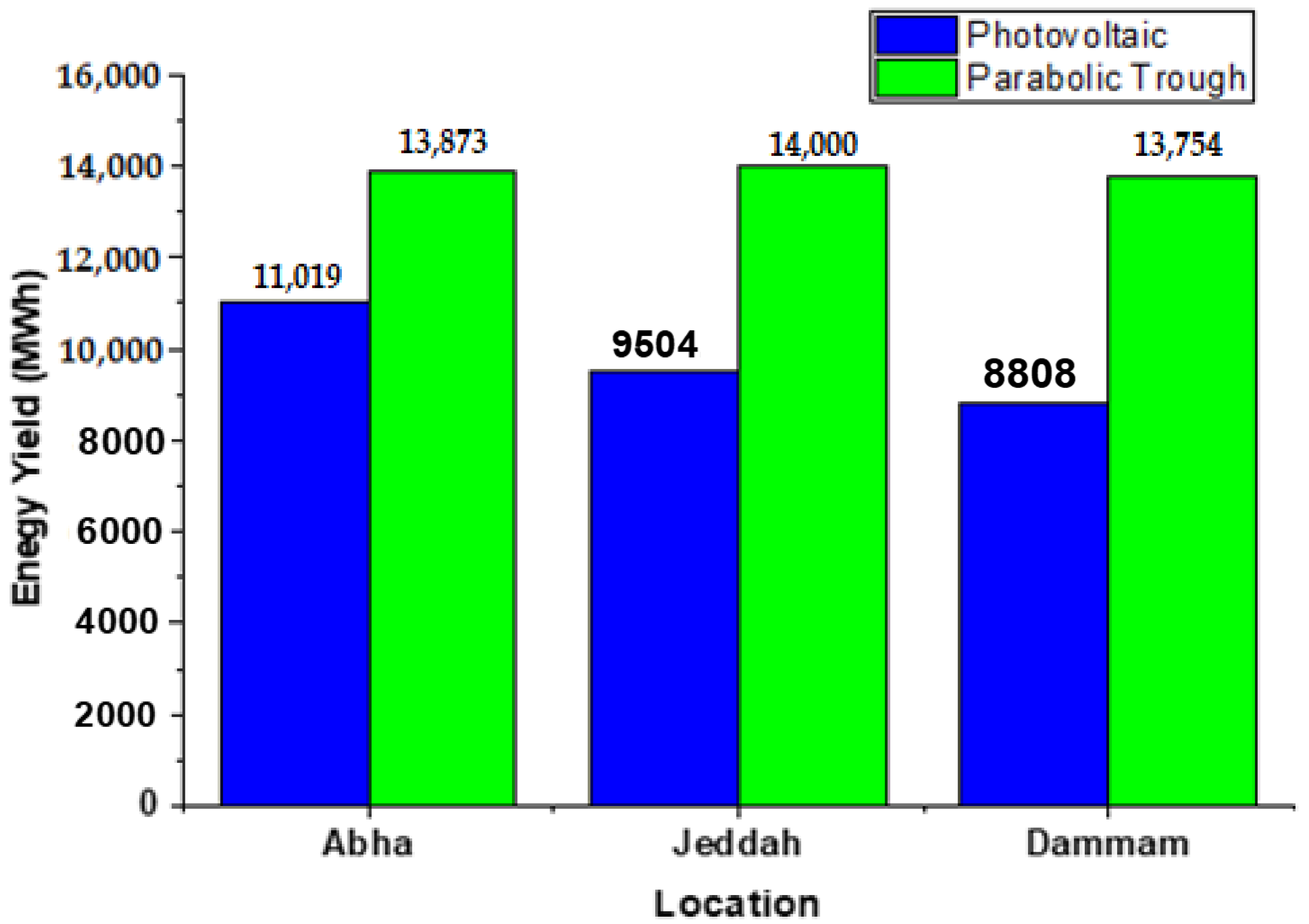

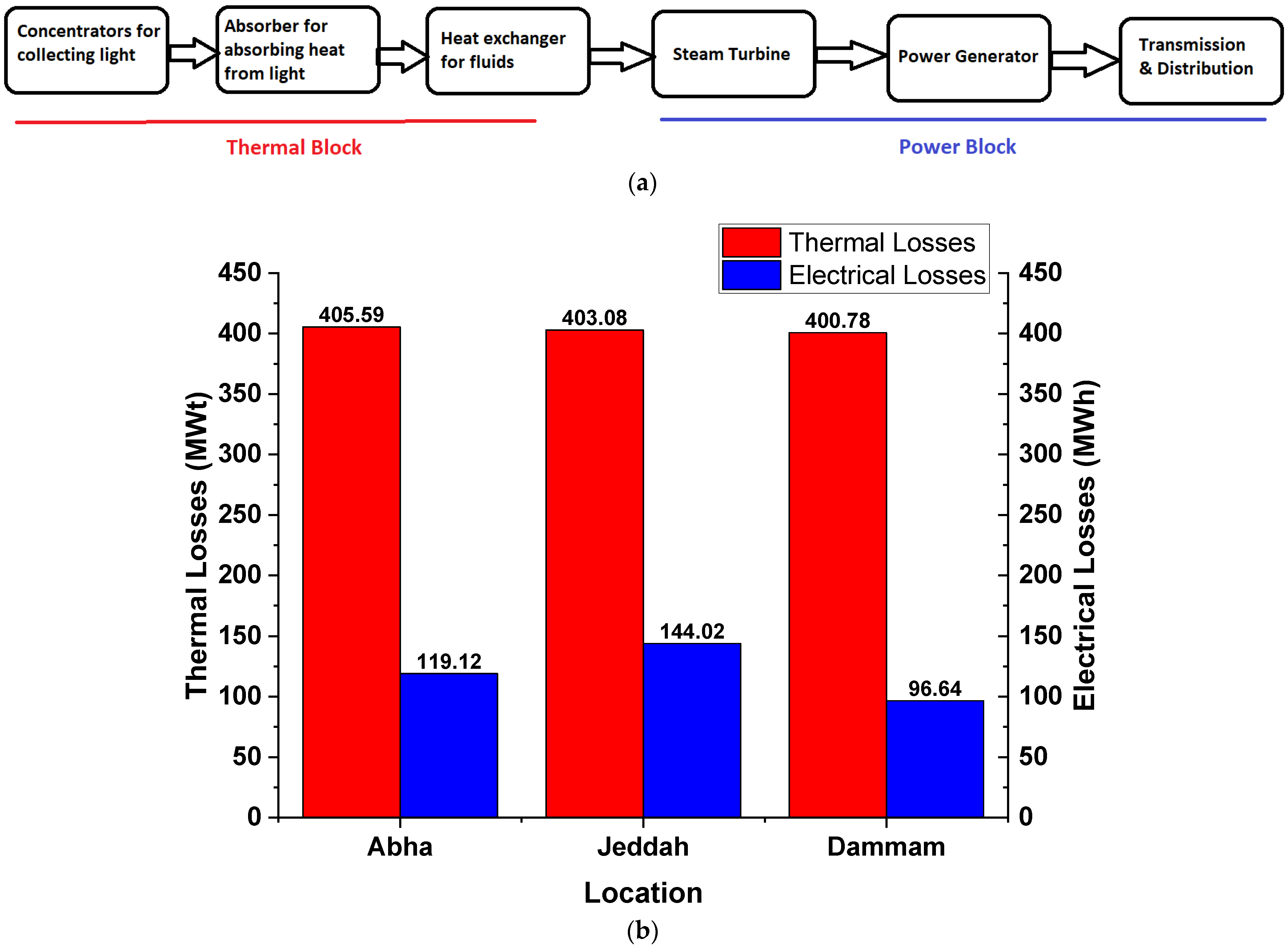
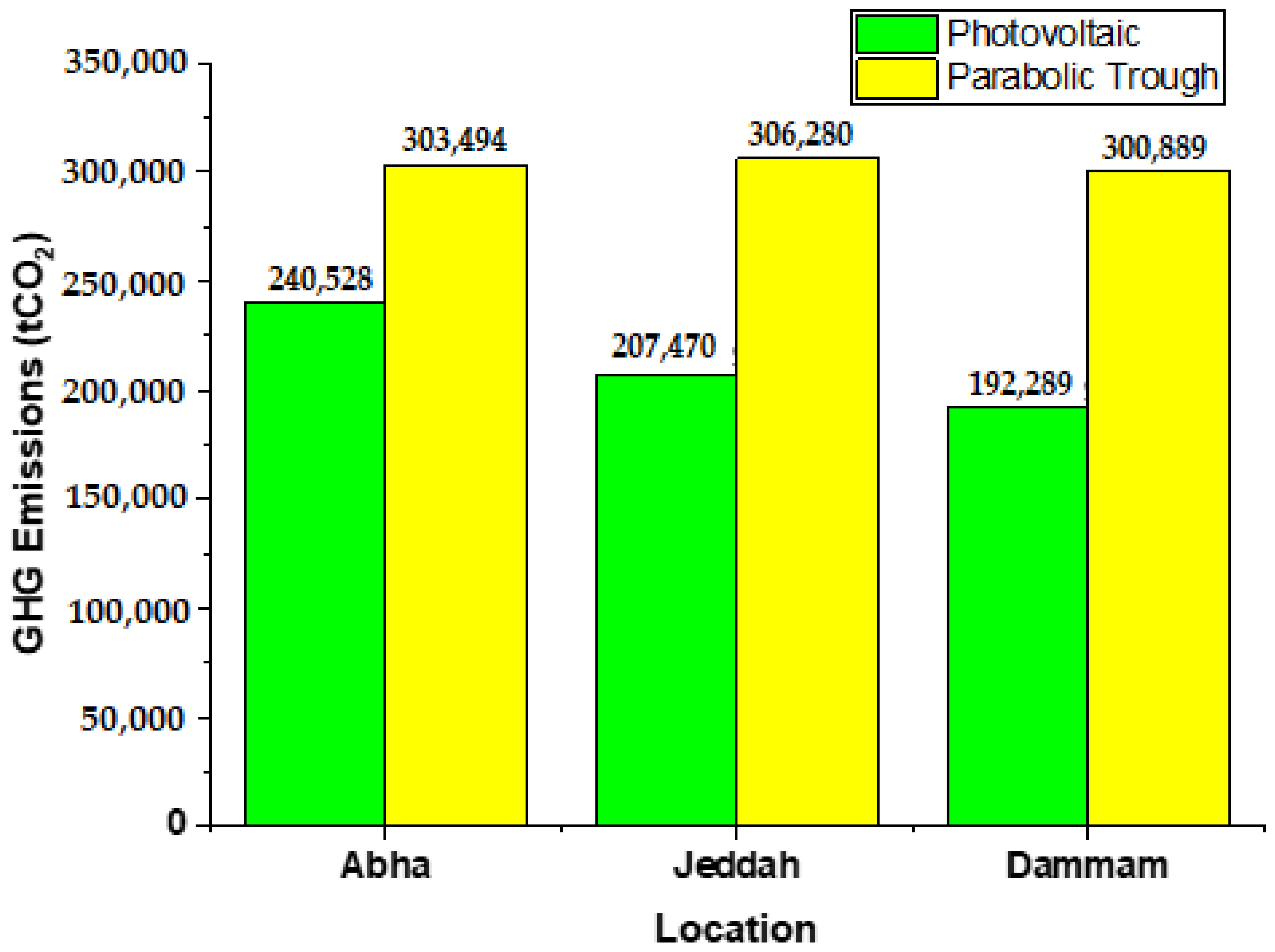
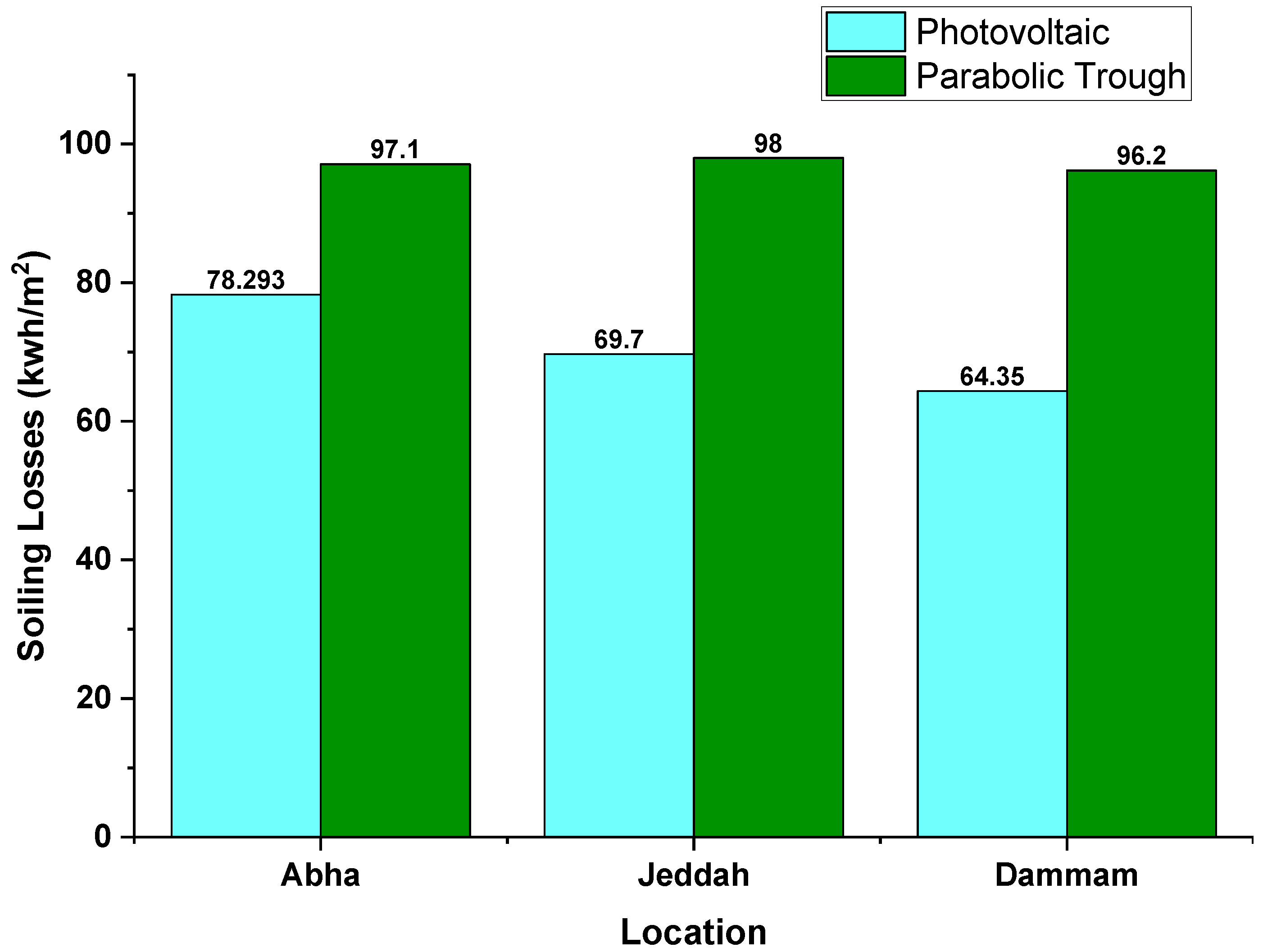
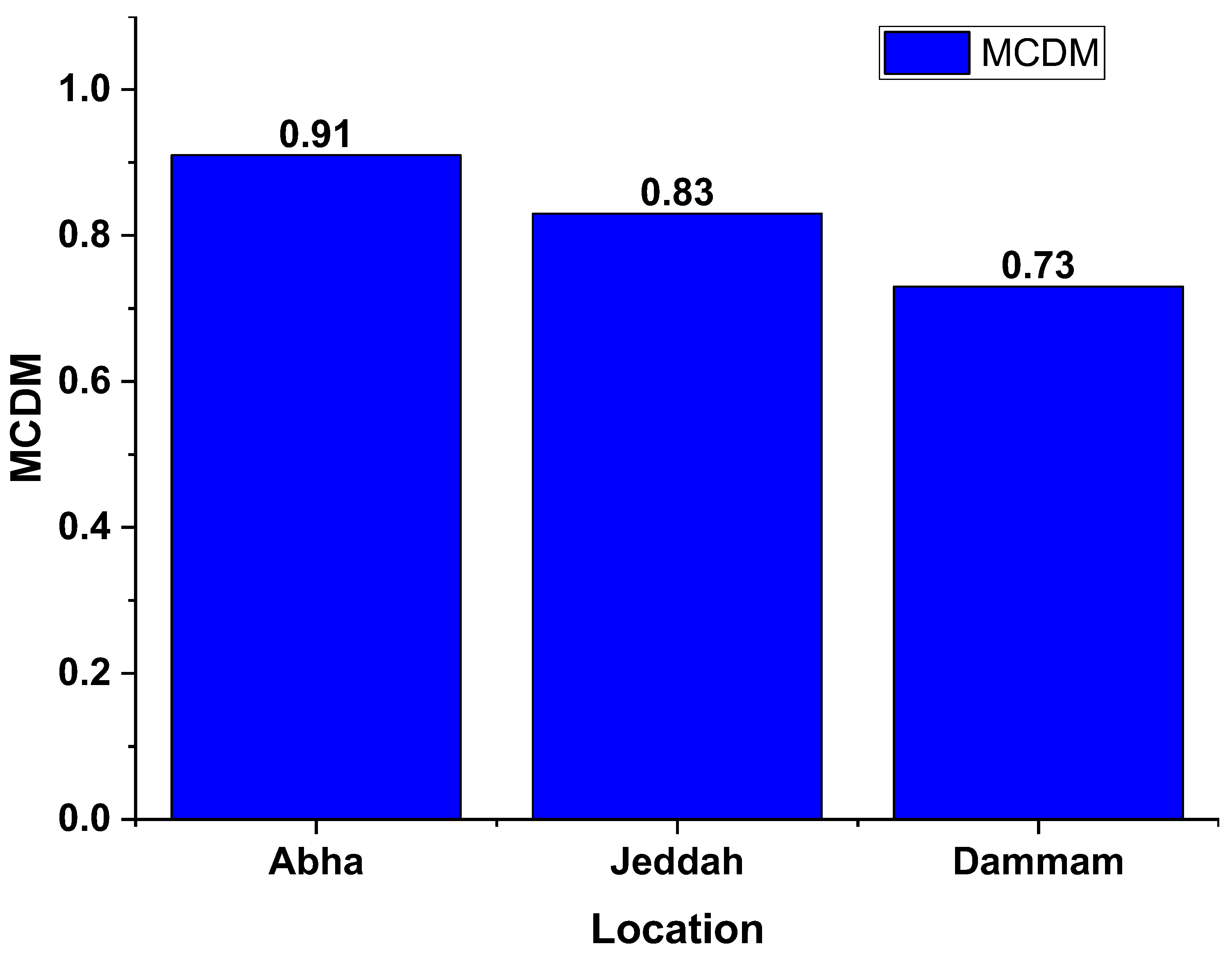
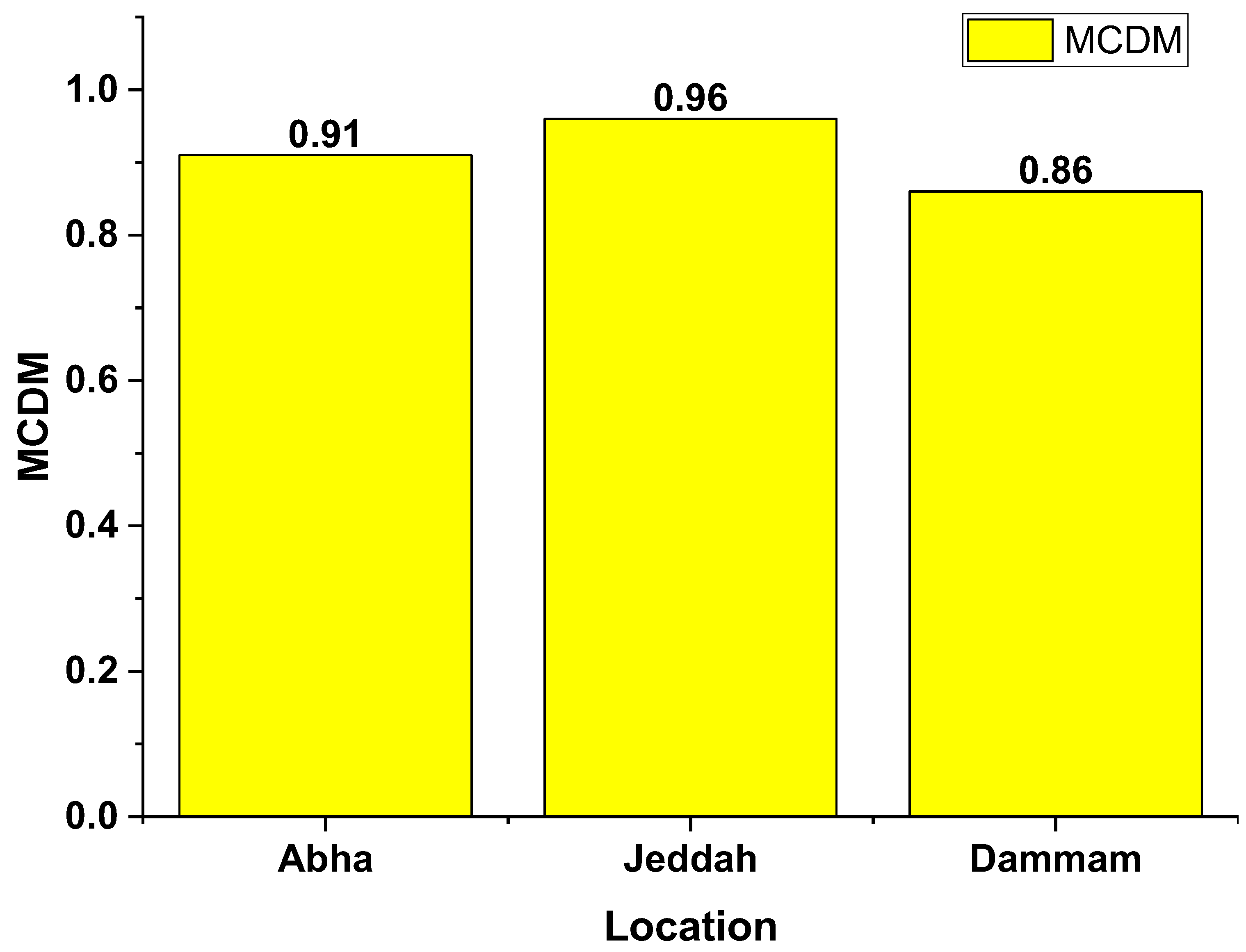
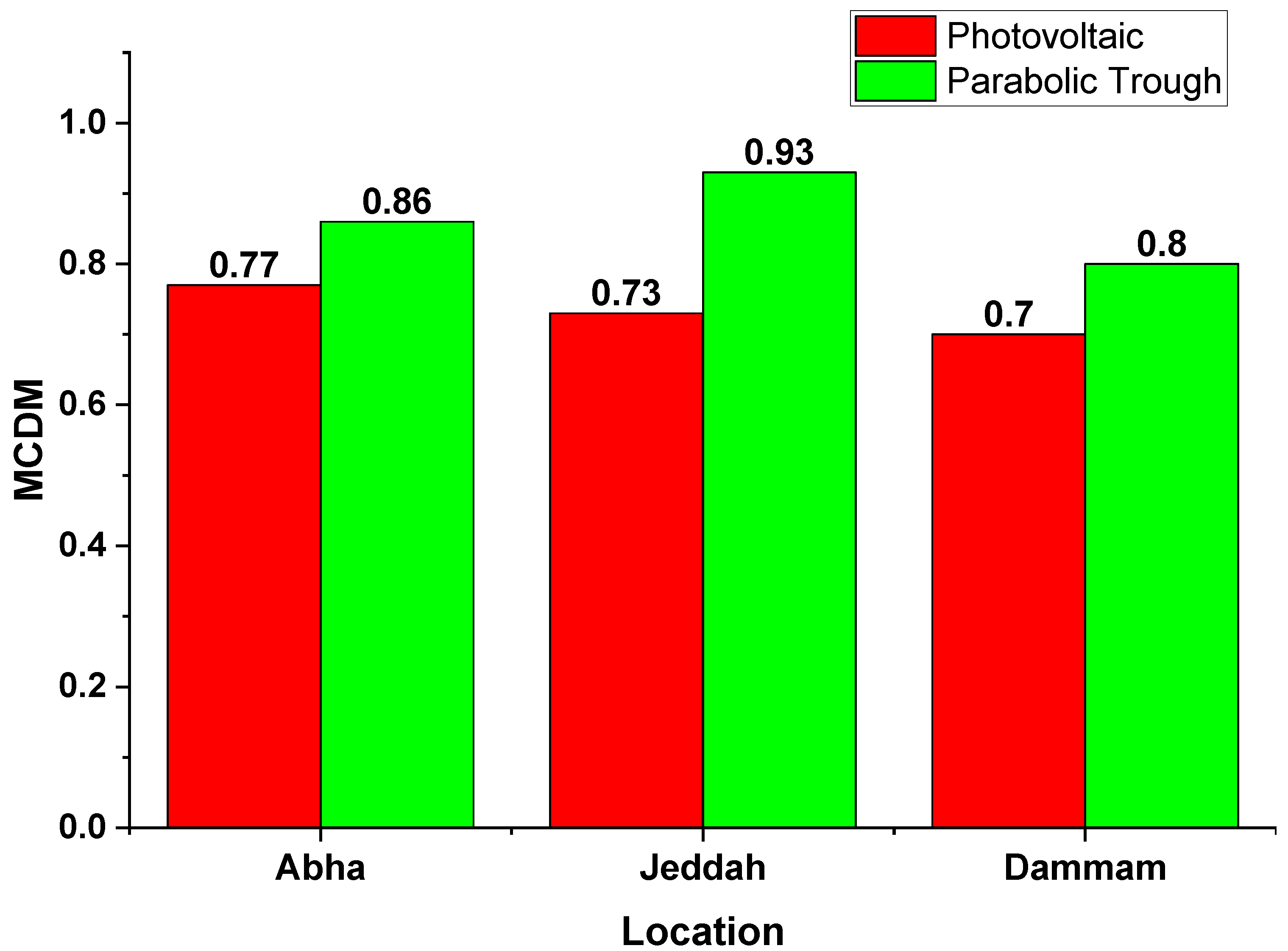
| Criteria Name | Type | Criteria Name | Type |
|---|---|---|---|
| C1: Solar Irradiance | Climate | C8: NPV | Economical |
| C2: Temperature | Climate | C9: Payback period | Economical |
| C3: Wind | Climate | C10: Electricity Export Revenue | Economical |
| C4: Humidity | Climate | C11: GHG Emissions | Environmental |
| C5: Energy Yield | Technical | C12: Soiling Loss | Environmental |
| C6: System Losses | Technical | C13: Population Density | Social |
| C7: LCOE | Economical |
| Intensity of Importance | Definition | Explanation |
|---|---|---|
| 1 | Equal Importance | Two factors contribute equally to the objective |
| 3 | Somewhat more important | Experience and Judgement slightly favor one over the other |
| 5 | Much more important | Experience and Judgement strongly favor one over other |
| 7 | Very much more important | Experience and Judgement very strongly favor one over the other. Its importance is demonstrated in one over the other |
| 9 | Absolutely more important | The evidence favoring one over the other is of the highest possible validity |
| 2, 4, 6, 8 | Intermediate Values | When compromise is needed |
| Solar Irr | Air Temp | Wind | Humidity | Energy Yield | System Loss | LCOE | NPV | PAY BACK | Electricity Export Revenue | GHG Emissions Saving | Soiling Loss | Population Density | |
|---|---|---|---|---|---|---|---|---|---|---|---|---|---|
| Solar Irr | 1 | 5 | 6 | 4 | 0.25 | 4 | 3 | 2 | 5 | 2 | 2 | 4 | 2 |
| Air Temp | 0.2 | 1 | 0.5 | 2 | 0.11 | 0.5 | 0.5 | 0.17 | 0.5 | 0.12 | 0.17 | 0.33 | 0.14 |
| Wind | 0.17 | 2 | 1 | 3 | 0.17 | 3 | 5 | 0.2 | 2 | 0.14 | 0.17 | 3 | 0.2 |
| Humidity | 0.25 | 0.5 | 0.33 | 1 | 0.14 | 2 | 2 | 0.2 | 2 | 0.17 | 0.17 | 2 | 0.14 |
| Energy Yield | 4 | 9 | 6 | 7 | 1 | 7 | 6 | 3 | 5 | 2 | 2 | 7 | 6 |
| System Loss | 0.25 | 2 | 0.33 | 0.5 | 0.14 | 1 | 2 | 0.2 | 2 | 0.14 | 0.12 | 2 | 0.14 |
| LCOE | 0.33 | 2 | 0.2 | 0.5 | 0.17 | 0.5 | 1 | 0.17 | 0.5 | 0.14 | 0.17 | 0.5 | 1 |
| NPV | 0.5 | 6 | 5 | 5 | 0.33 | 5 | 6 | 1 | 7 | 0.5 | 2 | 6 | 2 |
| PAYBACK | 0.2 | 2 | 0.5 | 0.5 | 0.2 | 0.5 | 2 | 0.14 | 1 | 0.17 | 0.17 | 3 | 0.2 |
| Electricity Export Revenue | 0.5 | 8 | 7 | 6 | 0.5 | 7 | 7 | 2 | 6 | 1 | 2 | 7 | 3 |
| GHG Emissions saving | 0.5 | 6 | 6 | 6 | 0.5 | 8 | 6 | 0.5 | 6 | 0.5 | 1 | 8 | 3 |
| Soiling Loss | 0.25 | 3 | 0.33 | 0.5 | 0.14 | 0.5 | 2 | 0.17 | 0.33 | 0.14 | 0.12 | 1 | 0.2 |
| Population Density | 0.5 | 7 | 5 | 7 | 0.17 | 7 | 1 | 0.5 | 5 | 0.33 | 0.33 | 5 | 1 |
| Sum | 8.65 | 53.5 | 38.19 | 43 | 3.82 | 46 | 43.5 | 10.25 | 42.33 | 7.35 | 10.42 | 48.83 | 19.02 |
| Solar Irr | Air Temp | Wind | Humidity | Energy Yield | System Loss | LCOE | NPV | PAY BACK | Electricity Export Revenue | GHG Emissions Saving | Soiling Loss | Population Density | |
|---|---|---|---|---|---|---|---|---|---|---|---|---|---|
| Solar Irr | 0.116 | 0.093 | 0.157 | 0.093 | 0.065 | 0.087 | 0.069 | 0.195 | 0.118 | 0.272 | 0.192 | 0.082 | 0.105 |
| Air Temp | 0.023 | 0.019 | 0.013 | 0.047 | 0.029 | 0.0109 | 0.011 | 0.017 | 0.012 | 0.016 | 0.016 | 0.007 | 0.007 |
| Wind | 0.02 | 0.037 | 0.026 | 0.07 | 0.045 | 0.0652 | 0.115 | 0.02 | 0.047 | 0.019 | 0.016 | 0.061 | 0.011 |
| Humidity | 0.029 | 0.009 | 0.009 | 0.023 | 0.037 | 0.0435 | 0.046 | 0.02 | 0.047 | 0.023 | 0.016 | 0.041 | 0.007 |
| Energy Yield | 0.462 | 0.168 | 0.157 | 0.163 | 0.262 | 0.1522 | 0.138 | 0.293 | 0.118 | 0.272 | 0.192 | 0.143 | 0.315 |
| System Loss | 0.029 | 0.037 | 0.009 | 0.012 | 0.037 | 0.0217 | 0.046 | 0.02 | 0.047 | 0.019 | 0.012 | 0.041 | 0.007 |
| LCOE | 0.038 | 0.037 | 0.005 | 0.012 | 0.045 | 0.0109 | 0.023 | 0.017 | 0.012 | 0.019 | 0.016 | 0.01 | 0.053 |
| NPV | 0.058 | 0.112 | 0.131 | 0.116 | 0.086 | 0.1087 | 0.138 | 0.098 | 0.165 | 0.068 | 0.192 | 0.123 | 0.105 |
| PAYBACK | 0.023 | 0.037 | 0.013 | 0.012 | 0.052 | 0.0109 | 0.046 | 0.014 | 0.024 | 0.023 | 0.016 | 0.061 | 0.011 |
| Electricity Export Revenue | 0.058 | 0.15 | 0.183 | 0.14 | 0.131 | 0.1522 | 0.161 | 0.195 | 0.142 | 0.136 | 0.192 | 0.143 | 0.158 |
| GHG Emissions saving | 0.058 | 0.112 | 0.157 | 0.14 | 0.131 | 0.1739 | 0.138 | 0.049 | 0.142 | 0.068 | 0.096 | 0.164 | 0.158 |
| Soiling Loss | 0.029 | 0.056 | 0.009 | 0.012 | 0.037 | 0.0109 | 0.046 | 0.017 | 0.008 | 0.019 | 0.012 | 0.02 | 0.011 |
| Population Density | 0.058 | 0.131 | 0.131 | 0.163 | 0.045 | 0.1522 | 0.023 | 0.049 | 0.118 | 0.045 | 0.032 | 0.102 | 0.053 |
| C1 | C2 | C3 | C4 | C5 | C6 | C7 | C8 | C9 | C10 | C11 | C12 | C13 |
|---|---|---|---|---|---|---|---|---|---|---|---|---|
| 0.127 | 0.018 | 0.042 | 0.027 | 0.218 | 0.026 | 0.023 | 0.115 | 0.026 | 0.149 | 0.122 | 0.022 | 0.085 |
| Parameter | Value |
|---|---|
| Field Type | Fixed Tilted Plane |
| System type | Grid Connected System |
| System Size | 5 MW |
| PV modules | Polycrystalline Silicon Suntech.STP_350_72_Vfh |
| PV Module Price | 0.18 $/W ($65) |
| nominal power | 350 Wp |
| maximum power point (Pmpp) | 350.5 W |
| open circuit voltage (Voc) | 46.6 V |
| maximum power point voltage (Vmpp) | 39.2 V |
| maximum power point current (Impp) | 8.930 A |
| short circuit current of PV module (Isc) | 9.520 A |
| Modules per String | 19 |
| Total Strings | 752 |
| Inverter | Sungrow |
| Inverter unit power | 1000 |
| Inverter Price | $22,000 |
| Inverter Efficiency | 98.79% |
| Inverter Quantity | 5 |
| Heat Transfer Fluid | HITEC Solar Salt | Collector | SkyFuel Sky Trough | Receiver | Schott PTR80 |
|---|---|---|---|---|---|
| HTF Cost | 60 $/m2 | Solar Field Cost | 150 $/m2 | Power Plant Cost | 910 $/kWe |
| Flow rate of Min Single loop | 1 kg/s | Aperture of Reflective | 656 m2 | Absorber Tube Inner Diameter | 0.076 m |
| Flow rate of Max Single Loop | 12 kg/s | Width of Area Aperture | 6 m | Absorber Tube Outer Diameter | 0.08 m |
| Min Velocity field flow | 0.268562 m/s | Collector assembly length | 115 m | Total Receiver Losses | 207.35 W/m |
| Max Velocity field flow | 3.74479 m/s | Water usage Per wash | 0.7 L/m2 | Washes per year | 63 |
| Parameter | Abha | Jeddah | Dammam |
|---|---|---|---|
| Latitude | 18.2268° | 21.4433° | 26.3542° |
| Longitude | 42.5387° | 39.2303° | 50.1703° |
| Altitude | 2198 m | 16 m | 21 m |
| Tilt Angle | 22° | 21° | 24° |
| Azimuth Angle | 0° | 0° | 0° |
| Criteria | Sub-Criteria | Abha | Jeddah | Dammam |
|---|---|---|---|---|
| Climatic | Solar Irradiation (kWh/m2/year) | 2470 | 2192 | 2019 |
| Temperature (°C) | 19.6 | 28.8 | 27.3 | |
| Wind Speed (m/s) | 3.1 | 2.5 | 4.3 | |
| Relative Humidity (%) | 48.8 | 58.2 | 46.5 |
| (a) | |||
|---|---|---|---|
| Abhac | Jeddah | Dammam | |
| January | 233.8 | 181.3 | 148.5 |
| February | 212.6 | 172.5 | 143.2 |
| March | 229.5 | 184.6 | 153.9 |
| April | 218.1 | 198.8 | 173.0 |
| May | 193.1 | 203.6 | 188.7 |
| June | 180.0 | 188.1 | 190.8 |
| July | 172.0 | 188.0 | 193.5 |
| August | 173.8 | 182.3 | 188.0 |
| September | 195.8 | 181.7 | 184.1 |
| October | 225.2 | 191.2 | 169.7 |
| November | 216.5 | 164.6 | 145.7 |
| December | 219.7 | 155.5 | 140.0 |
| Year | 2470.0 | 2192.2 | 2019.2 |
| (b) | |||
| January | 2.4 | 2.365 | 3.212 |
| February | 2.4 | 2.504 | 2.997 |
| March | 3.0 | 3.157 | 4.450 |
| April | 3.0 | 3.231 | 3.984 |
| May | 4.0 | 3.761 | 4.395 |
| June | 4.2 | 4.086 | 4.154 |
| July | 5.0 | 4.340 | 4.197 |
| August | 4.9 | 4.129 | 4.147 |
| September | 3.4 | 3.212 | 3.035 |
| October | 2.8 | 2.772 | 3.426 |
| November | 1.9 | 2.699 | 3.321 |
| December | 1.5 | 3.135 | 3.321 |
| Year | 38.4 | 39.391 | 44.639 |
| Photo Voltaic Energy Yield (MWh) | Parabolic Trough Energy Yield (MWh) | |||||
|---|---|---|---|---|---|---|
| Abha | Jeddah | Dammam | Abha | Jeddah | Dammam | |
| January | 1058.0 | 807.9 | 689.3 | 1068.2 | 961.2 | 58,276.9 |
| February | 956.0 | 763.3 | 657.3 | 1000.8 | 1041.2 | 53,225.9 |
| March | 1025.0 | 809.7 | 692.1 | 1202.4 | 1285.0 | 60,010 |
| April | 972.0 | 857.7 | 759.9 | 1265.2 | 1302.6 | 61,632.9 |
| May | 857.0 | 867.9 | 803.5 | 1259.6 | 1289.2 | 69,892.5 |
| June | 795.0 | 802.7 | 800.6 | 1191.8 | 1396.5 | 82,652.5 |
| July | 760.0 | 798.2 | 806.3 | 1141.1 | 1383.2 | 85,352.7 |
| August | 768.0 | 775.4 | 785.5 | 1110.4 | 1181.2 | 86,439.3 |
| September | 862.0 | 780.2 | 779.7 | 1110.1 | 1240.2 | 72,097 |
| October | 995.0 | 822.4 | 735.4 | 1256.8 | 1079.1 | 65,319.2 |
| November | 972.0 | 724.4 | 654.3 | 1121.1 | 890.8 | 56,363.1 |
| December | 999.0 | 694.3 | 644.6 | 1109.0 | 949.5 | 57,827.4 |
| Year | 11,019.0 | 9504.2 | 8808.8 | 13,873.12 | 14,000.14 | 13,754.31 |
| Temperature Losses (MWh) | Inverter Efficiency Loss (MWh) | Total Losses in the System (MWh) | |||||||
|---|---|---|---|---|---|---|---|---|---|
| Abha | Jeddah | Dammam | Abha | Jeddah | Dammam | Abha | Jeddah | Dammam | |
| January | 66.9 | 66.6 | 26.7 | 12.8 | 9.9 | 7.852 | 82.0 | 78.825 | 37.764 |
| February | 68.2 | 68.8 | 33.0 | 11.2 | 8.9 | 7.722 | 81.8 | 80.174 | 43.719 |
| March | 79.5 | 81.0 | 48.8 | 12.3 | 9.3 | 8.598 | 94.8 | 93.467 | 61.848 |
| April | 78.9 | 100.8 | 74.2 | 11.6 | 10.7 | 9.259 | 93.4 | 114.701 | 87.443 |
| May | 73.7 | 114.3 | 107.0 | 10.2 | 10.6 | 9.574 | 87.9 | 128.671 | 120.969 |
| June | 72.2 | 105.0 | 120.3 | 9.8 | 9.5 | 9.399 | 86.2 | 118.596 | 133.853 |
| July | 67.1 | 109.2 | 127.7 | 9.6 | 9.4 | 9.602 | 81.8 | 122.960 | 141.499 |
| August | 68.1 | 103.5 | 121.7 | 9.4 | 9.8 | 9.664 | 82.3 | 117.419 | 135.511 |
| September | 81.4 | 96.5 | 109.5 | 10.4 | 9.5 | 9.120 | 95.1 | 109.172 | 121.655 |
| October | 89.3 | 100.4 | 83.7 | 12.3 | 10.0 | 8.435 | 104.4 | 113.172 | 95.561 |
| November | 70.9 | 70.4 | 48.1 | 11.5 | 8.4 | 8.068 | 84.3 | 81.509 | 59.489 |
| December | 61.4 | 56.1 | 30.2 | 11.4 | 8.2 | 7.856 | 74.3 | 67.405 | 41.377 |
| Year | 877.6 | 1072.6 | 930.8 | 132.3 | 114.1 | 105.149 | 1080.588 | 1226.081 | 1048.3 |
| Total Thermal Losses (MWt) | Total Electrical Losses (MWh) | |||||
|---|---|---|---|---|---|---|
| Abha | Jeddah | Dammam | Abha | Jeddah | Dammam | |
| January | 34.64 | 33.60 | 32.28 | 8.89 | 8.63 | 7.016 |
| February | 31.61 | 31.38 | 31.31 | 8.09 | 8.1 | 6.99 |
| March | 35.27 | 34.75 | 34.34 | 10.13 | 13.67 | 7.036 |
| April | 33.93 | 33.43 | 33.59 | 11.01 | 15.46 | 8.154 |
| May | 34.50 | 34.86 | 34.39 | 10.68 | 14.15 | 8.83 |
| June | 33.05 | 33.55 | 33.40 | 11.29 | 13.84 | 9.528 |
| July | 34.00 | 34.33 | 34.70 | 11.09 | 13.71 | 9.111 |
| August | 34.13 | 34.68 | 33.83 | 10.19 | 10.91 | 9.094 |
| September | 33.05 | 32.98 | 32.91 | 9.51 | 12.78 | 9.061 |
| October | 33.99 | 33.77 | 33.50 | 9.25 | 14.18 | 8.379 |
| November | 33.31 | 31.92 | 32.95 | 9.21 | 9.9 | 6.899 |
| December | 34.07 | 33.78 | 33.53 | 9.2 | 8.7 | 6.552 |
| Year | 405.59 | 403.08 | 400.78 | 119.12 | 144.02 | 96.649 |
| Abha | Jeddah | Dammam | ||||
|---|---|---|---|---|---|---|
| PV | Parabolic | PV | Parabolic | PV | Parabolic | |
| System Production (MWh/yr) | 11,018.61 | 13,873.12 | 9504.25 | 14,000.14 | 8808.82 | 13,754.31 |
| Grid Lifecycle Emission (gCO2/kWh) | 743 | 743 | 743 | 743 | 743 | 743 |
| Lifetime (Years) | 30 | 30 | 30 | 30 | 30 | 30 |
| Annual Degradation | 1% | 1% | 1% | 1% | 1% | 1% |
| Replaced Emission (tCO2) | 245,604.9 | 309,231.84 | 211,849.6 | 312,063.12 | 196,348.6 | 306,583.56 |
| PV Cycle Emission (tCO2) | 5075.99 | 5737.32 | 4379.38 | 5783.04 | 4059.48 | 5694.16 |
| Saved CO2 Emission (tCO2) | 240,528.91 | 303,494.52 | 207,470.22 | 306,280.08 | 192,289.12 | 300,889.40 |
| Criteria | Sub-Criteria | Abha | Jeddah | Dammam | Abha | Jeddah | Dammam |
|---|---|---|---|---|---|---|---|
| PV | Thermal | ||||||
| Economic | Levelized Cost of Electricity ($/Mwh) | 32 | 37 | 40 | 152 | 147 | 155 |
| NPV ($) | 2,614,138 | 1,835,208 | 1,477,260 | 3,685,980 | 3,697,310 | 3,680,650 | |
| Payback Period (Year) | 4.6 | 5.6 | 6.3 | 10.5 | 10.2 | 10.9 | |
| Electricity Export Revenue ($/Mwh) | 518,864 | 44,6121 | 421,693 | 649,256 | 655,220 | 639,587 | |
| C1 | C2 | C3 | C4 | C5 | C6 | C7 | C8 | C9 | C10 | C11 | C12 | C13 | |
|---|---|---|---|---|---|---|---|---|---|---|---|---|---|
| Abha | 2470 | 19.6 | 3.1 | 48.8 | 11,085 | 1080.5 | 32 | 2,614,138 | 4.6 | 518,864 | 240,528 | 78.3 | 2,344,220 |
| Jeddah | 2192 | 28.8 | 2.5 | 58.2 | 9804 | 1226 | 37 | 1,835,208 | 5.6 | 446,121 | 207,470 | 69.7 | 9,251,157 |
| Dammam | 2019 | 27.3 | 4.3 | 46.5 | 9208 | 1048 | 40 | 1,477,260 | 6.3 | 421,693 | 192,289 | 64.35 | 1,303,588 |
| C1 | C2 | C3 | C4 | C5 | C6 | C7 | C8 | C9 | C10 | C11 | C12 | C13 | |
|---|---|---|---|---|---|---|---|---|---|---|---|---|---|
| Abha | 2470 | 19.6 | 3.1 | 48.8 | 13,873 | 1480 | 155 | 3,685,980 | 10.5 | 649,256 | 303,494 | 97.1 | 2,344,220 |
| Jeddah | 2192 | 28.8 | 2.5 | 58.2 | 14,000 | 1526 | 147 | 3,697,310 | 10.2 | 655,220 | 306,280 | 98 | 9,251,157 |
| Dammam | 2019 | 27.3 | 4.3 | 46.5 | 13,754 | 1418 | 150 | 3,680,650 | 10.9 | 639,587 | 300,889 | 96.4 | 1,303,588 |
| C1 | C2 | C3 | C4 | C5 | C6 | C7 | C8 | C9 | C10 | C11 | C12 | C13 | |
|---|---|---|---|---|---|---|---|---|---|---|---|---|---|
| A1(PV) | 2470 | 19.6 | 3.1 | 48.8 | 11,085 | 1080.5 | 32 | 2,614,138 | 4.6 | 518,864 | 240,528 | 78.3 | 2,344,220 |
| A1(PT) | 2470 | 19.6 | 3.1 | 48.8 | 13,873 | 1480 | 155 | 3,685,980 | 10.5 | 649,256 | 303,494 | 97.1 | 2,344,220 |
| A2(PV) | 2192 | 28.8 | 2.5 | 58.2 | 9804 | 1226 | 37 | 1,835,208 | 5.6 | 446,121 | 207,470 | 69.7 | 9,251,157 |
| A2(PT) | 2192 | 28.8 | 2.5 | 58.2 | 14,000 | 1526 | 147 | 3,697,310 | 10.2 | 655,220 | 306,280 | 98 | 9,251,157 |
| A3(PV) | 2019 | 27.3 | 4.3 | 46.5 | 9208 | 1048 | 40 | 1,477,260 | 6.3 | 421,693 | 192,289 | 64.35 | 1,303,588 |
| A3(PT) | 2019 | 27.3 | 4.3 | 46.5 | 13,754 | 1418 | 150 | 3,680,650 | 10.9 | 639,587 | 300,889 | 96.4 | 1,303,588 |
Disclaimer/Publisher’s Note: The statements, opinions and data contained in all publications are solely those of the individual author(s) and contributor(s) and not of MDPI and/or the editor(s). MDPI and/or the editor(s) disclaim responsibility for any injury to people or property resulting from any ideas, methods, instructions or products referred to in the content. |
© 2023 by the authors. Licensee MDPI, Basel, Switzerland. This article is an open access article distributed under the terms and conditions of the Creative Commons Attribution (CC BY) license (https://creativecommons.org/licenses/by/4.0/).
Share and Cite
Alanazi, A.; Alanazi, M. Multicriteria Decision-Making for Evaluating Solar Energy Source of Saudi Arabia. Sustainability 2023, 15, 10228. https://doi.org/10.3390/su151310228
Alanazi A, Alanazi M. Multicriteria Decision-Making for Evaluating Solar Energy Source of Saudi Arabia. Sustainability. 2023; 15(13):10228. https://doi.org/10.3390/su151310228
Chicago/Turabian StyleAlanazi, Abdulaziz, and Mohana Alanazi. 2023. "Multicriteria Decision-Making for Evaluating Solar Energy Source of Saudi Arabia" Sustainability 15, no. 13: 10228. https://doi.org/10.3390/su151310228
APA StyleAlanazi, A., & Alanazi, M. (2023). Multicriteria Decision-Making for Evaluating Solar Energy Source of Saudi Arabia. Sustainability, 15(13), 10228. https://doi.org/10.3390/su151310228







